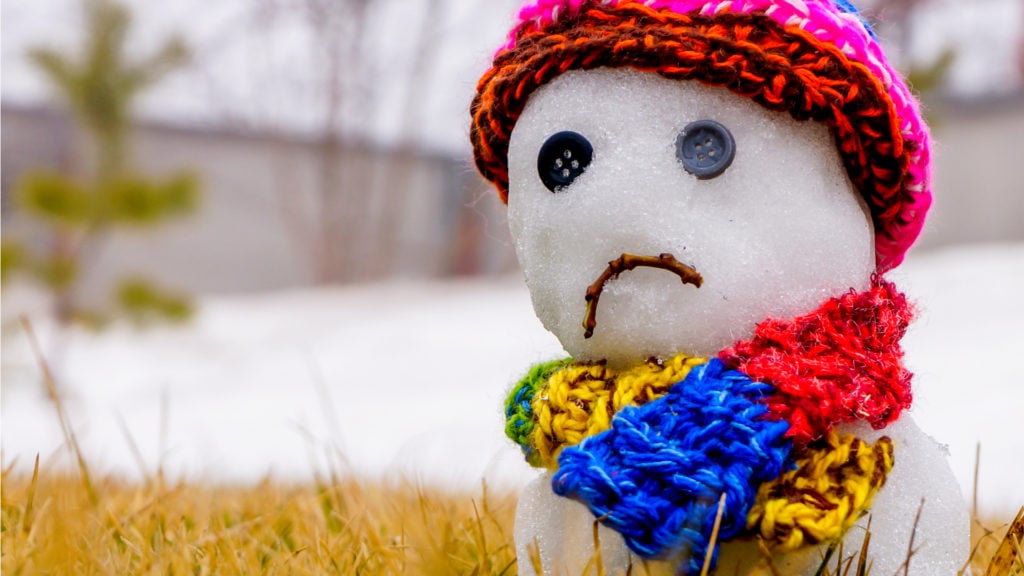Seasonal depression is often one of those things that people like to self-diagnose, with many believing that the shorter days, colder weather and increased isolation leads to negative thoughts or actions. While that may be true, it’s important to understand the similarities and differences with clinical depression, because some guys may have a bigger issue than just the time of year.
It was told to me earlier today that December is, in fact, the loneliest month of the year. From the weather, to the anxiety and pressure of the holidays, it’s easy to see why so many people might claim to be lonesome and/or say they have seasonal depression around this time of year. However, if a lot of the same negativity is lasting into the new year and beyond, it might be time to seriously consider talking to someone about what’s going on.
We’re here to help you understand better some of the things to look for when it comes to both seasonal depression and clinical depression, so educate yourselves a bit with the info below.
What is seasonal depression?
Commonly referred to as seasonal affective disorder, or SAD, seasonal depression is estimated to impact about 4-6 percent of U.S. citizens each year. That’s important to understand, because, all too often, many people want to blame their problems on the weather and/or month atop the calendar. That’s not always the right thing to do, though, as the issues may be deeper than that.
Many symptoms of seasonal depression are things like anxiety, an increase in irritability, simple fatigue and weight gain due to less activity. There’s no common answer as to why this effects some people, but it’s critical to understand that it throwing out the term “seasonally depressed” shouldn’t be used to describe a bad day or, worse, a few bad months, because it doesn’t actually impact that many people.
What is clinical depression?
For those who have serious thoughts of harming themselves or others, or feel as if they don’t have a purpose or end to the negativity going on in their lives, one shouldn’t self-diagnose seasonal depression. That’s because the issues are much more serious, and need to be addressed immediately with a professional.
Some signs of clinical depression are things like emptiness, hopelessness, outbursts towards others, loss of interest in activities (including sex), insomnia, a reduced appetite, increased anxiety, feelings of worthlessness due to past failures and unexplained body or head aches. The most pressing issue is of any harm or suicide, so, if any of these things are happening to you, make sure to call the 24/7 depression hotline.
So, what are some myths about seasonal depression then?
It’s not uncommon for certain mental health issues to have myths, and, when it comes to seasonal depression, there are plenty. Here are some common ones that you need to understand in order to differentiate between sadness for a few months and something bigger, where you should consider talking to a professional or take medication.
- Seasonal depression is the same as the winter blues. Many people may think this, but winter blues can often be treated by catching up on sleep and finding activities that aren’t so isolated — like a workout routine.
- Seasonal depression only occurs during the winter. Sorry, fellas, but this isn’t right either. Sure, seasonal depression is most commonly associated with the fall and winter because of the temperature changes and such, but it can also impact people during the spring and summer as well.
- Seasonal depression lasts throughout the year. Seasonal depression certainly can last for a few months, but as stated above, if you find yourself with some of the above symptoms all year long, it might be time to see a professional to find the diagnosis. Having a couple bad days or weeks can be tough — but that’s common, and shouldn’t be assumed to be seasonal depression, no matter what time of year it is. When negative thoughts or irritability run throughout the year, that may be a sign of clinical depression.
- Seasonal depression only happens to girls. Nope, this is a myth that needs to be squashed, because seasonal depression doesn’t lean only to females. Sure, it’s believed that about 60-70 percent of people suffering from seasonal depression are female, but that means about 30-40 percent are men, so it doesn’t discriminate.
- Seasonal depression isn’t as serious as clinical depression. Any type of depression is serious, no matter if it’s defined as seasonal or not. Even if a person is diagnosed with seasonal depression, it can be crippling, and can require medication to help boost them a little bit during this time of year. If you experinece some of the signs we listed above at any point throughout the year, talk to a professional to try and get a diagnoses.
Mental health awareness is critical in understanding what we might be thinking or how we might act, so remember to read as much as you can to educate yourselves. There’s a major difference between a lonesome week and thoughts of worthlessness all week long. Likewise, it’s common to feel tired or sluggish during the winter as the days are shorter. It’s a much bigger issue when you’re experiencing headaches due to anxiety or self-doubt.
Remember, regardless of a diagnoses or not, if you’re ever feeling like you need help or want to talk to someone, know that the 24/7 depression hotline is an available resource.




Leave a Comment